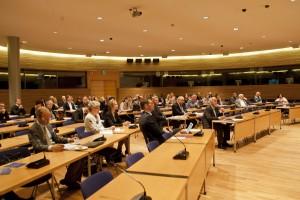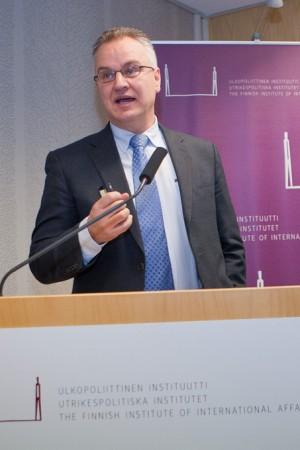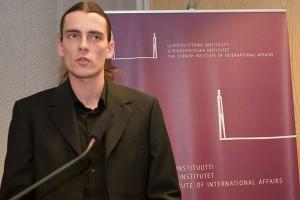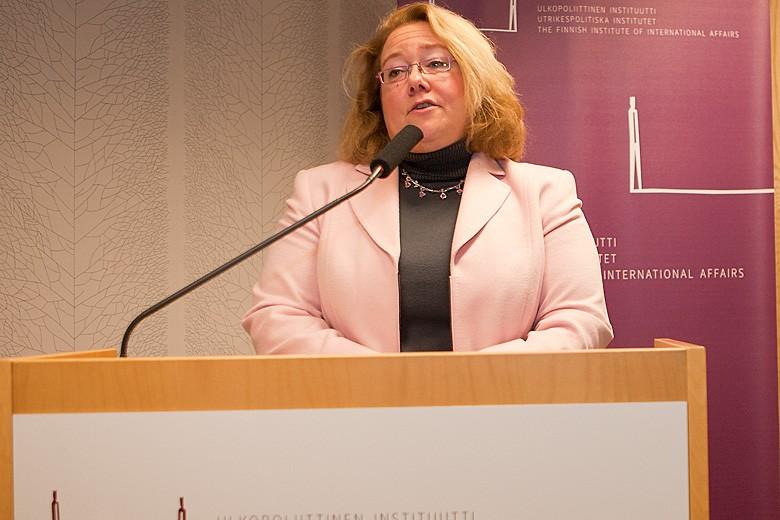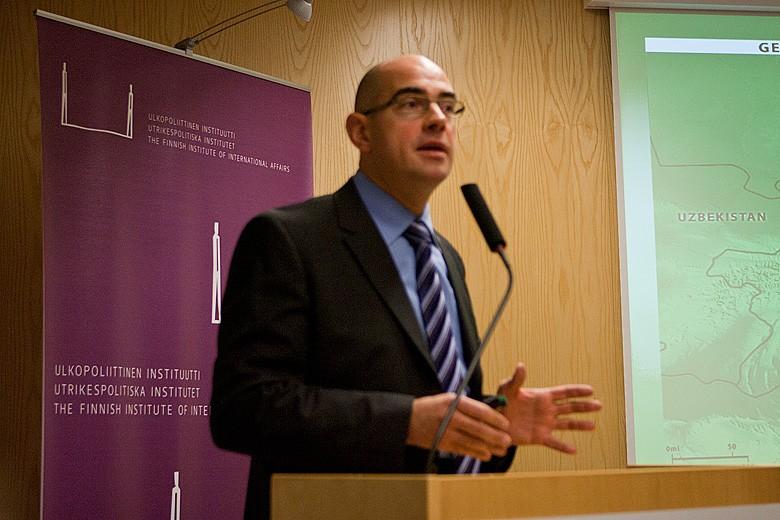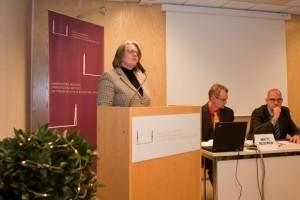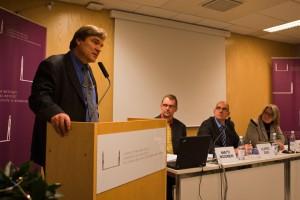Approaches to Central Asia and Afghanistan tend to revolve around issues of Soviet legacy, geo-political interests and resource and security concerns. All too often the focus is on state-level policies. However, Central Asia is a context of insurgency, the narcotics trade and complex ethno-nationalism, and hence local and inter-regional aspects cannot be forgotten – they influence political stability. This seminar primarily asks: how do these factors affect the states in Central Asia? What implications do the ethno-political currents in the region have for the international community? Non-traditional actors such as NATO and the OSCE are increasingly active in Central Asia and these new geo-political forces and interests can have a large impact in the region and its people.
PROGRAMME
9:00-10:45
SESSION 1: Local and regional perspectives on Central Asian borderlands
Opening and Chair:
Teija Tiilikainen, Director,
Finnish Institute of International Affairs
Speakers:
Kristian Berg Harpviken, Director,
Peace Research institute Oslo (PRIO), Norway
Steven Parham, Author of the FIIA Report: Controlling Borderlands?
Tuula Yrjölä, Roving Ambassador for Central Asia,
Ministry for Foreign Affairs of Finland
Discussion
11:00-12:30
SESSION 2: Implemention of state power in the border regions of southern Central Asia
Chair:
Matti Nojonen, Programme Director,
Finnish Institute of International Affairs
Speakers:
Zlatko Zigic, Sub-Regional Coordinator for Central Asia; Chief of Mission, International Organisation for Migration (IOM) Missions in Kazakhstan, the Kyrgyz Republic, Turkmenistan and Uzbekistan
Kimmo Kiljunen, OSCE Parliamentary Assembly’s special representative for Central Asia, Member of Parliament, Finland
Kerstin Kronvall, Journalist, Finnish Broadcasting Company (YLE)
Discussion
Concluding Remarks:
Tuula Yrjölä, Roving Ambassador for Central Asia,
Ministry for Foreign Affairs of Finland
Summary of the seminar
Dr Teija Tiilikainen, director of the Finnish Institute of International Affairs, opened session one of the seminar by warmly welcoming the speakers of and the audience to the event. She continued with a brief introduction of Dr Steven Parham’s report and congratulated the author for the new perspectives it offers to the research on the topic.
Mr Kristian B. Harpviken, director of the Peace Research Institute in Oslo, started his presentation by saying he would offer a different perspective on the topic than the one presented in Dr Parham’s report. He based his presentation and arguments on a previous article of his. Mr. Harpviken presented the position of Afghanistan and its troubled status in the area from a regional security perspective. His base assumption is that Afghanistan serves as an “insulator”, i.e. an area that is caught in the middle of the three areas surrounding it (South Asia, the Persian Gulf and Central Asia), and their state systems. Afghanistan thus is an area that reflects the security concerns of each surrounding state. Mr. Harpviken suggested that in order to make Afghanistan a more secure area, a strategy that promises more than security integration with its neighbors would be necessary. In Mr Harpviken’s view, granting and negotiating a neutral status for Afghanistan — in a special forum, with the understanding of the special position of Afghanistan, could be more beneficial than the more mainstream policy proposals. A regional security centered approach and an analyses of Afghanistan’s position in its geopolitical context could help highlight the security relationships in the area. This approach would help in seeing the situation in the region not only as something caused by issues coming from inside Afghanistan, but as a reflection of the larger security threats in the surrounding areas and states. Afghanistan has indeed for years served as a battleground of conflicts originally stemming from its neighboring countries.
The floor was then open for Dr. Steven Parham, author of the report in question. Dr Parham addressed the subject from more local and regional perspectives, following the course of his research on the matter. In his presentation he introduced some new ways of thinking about state borders, i.e. through a bottom-up point of view that is gained from observing the interactions between forces of border control and the borderlands, rather than merely taking into account views coming from state centers. The research concentrated not on the traditional security issues of the international community, i.e. how the states and powerful state actors deal with border control, but on what actually happens at the borders. This includes observing the inhabitants of the border areas, border control and the impact of border related issues on the populations, and finally how the borders resonate back to the state centers. Dr Parham’s main research questions were: how are borders controlled; how is control perceived by people in the area, what narratives of power and discourses of control emerge, and how are political loyalties negotiated at the edges of the states.
Dr Parham’s report is divided into three parts: (1) interactions between state and periphery in the region today, and how the Soviet legacy is still influencing the area (2) the dynamics of the interactions within borderland areas, in particular focusing on local elites; and (3) agents and means of border control, ethnic minorities, “gate-keepers” and changes in power at the border areas.
Ms Tuula Yrjölä, Roving Ambassador for Central Asia, offered a “diplomat’s viewpoint” into the subject. She stated that poverty, hopelessness, political and economic instability, as well as environmental problems and poor living conditions can all lead to instability in Central Asia. Weak centers and feeble central governments in the region constitute weak states in which regional leaders such as the local elite of the border areas, have more power over the populations and end up taking over the tasks of the central governments. This leads to lack of governance and transparency, and to a situation where the area is divided into different rivaling groups. With authority and legitimacy regionally fragmented, the disjoined areas within a state become very challenging to control from the centre. State building and education on “modern state management skills” are a requirement from the part of the international community in aiding the area to become more stabile and secure. Ms Yrjölä stated that the sympathies of ethnic minorities, regional legitimacy, as well as internal legitimacies, do not necessarily follow state borders, and this resolves into a situation where a comprehensive approach is needed in order to stabilize and modernize the governance of the areas.
After the session one presentations some very good questions arose from the audience. One question dealt with whether the border regions also serve as alliance building areas for the Al Qaeda and other insurgent networks. Dr Parham answered by saying that although the threat is somewhat real, the border area populations and the regional leaders do also purposefully use the language of threat when addressing central governments and the international community. This is sometimes done to lure funds and economic commodities into the area. Even state actors may sometimes overstate the presence of Taliban related groups in order to get help from the international community, and thus the threat of terrorism is used as a resource.
When asked about the role of China in the region, the speakers all agreed that the role and influence of China in the area is increasingly important. Dr Parham added that the Chinese influence in border areas is very visible, with the presence of Chinese companies and workers on the increase. Ms Yrjölä added that the Chinese influence can be seen both as a positive and a negative thing. More affordable consumer products have entered the markets, and China a notable actor in infrastructure building in these areas. But unlike many western countries for example, China is not interested in human rights or human security issues, and thus can be seen as a potential rival power in the area. On the role of India on the other hand, Mr. Harpviken’s analysis was that India’s engagement in the area is first and foremost economic, and after 2001 India has strengthened its developmental presence and action in the area quite significantly.
Session two of the seminar was opened by Dr Matti Nojonen, program director at the Finnish Institute for International Affairs, by introducing the final three speakers. Mr Zlatko Zigic, Sub-Regional Coordinator for Central Asia, and Chief of Mission with the International Organization for Migration (IOM), then gave a presentation about the practical work done by IOM in Central Asia, giving a “practitioner’s point of view” on the topic of the seminar. Central Asia, Mr Zigic noted, appears in international statistics in a very bleak way: four of the Central Asian countries are in the top 15 of most corrupt countries in the world, and poverty is so widespread that 80 per cent of the population is forced to persist on less than 2 USD a day. Such deep problems lead to instability and conflict. Looking at the map, Central Asia is a region where borders don’t stop influences, trade and other issues from overlapping, and where the ethnic picture in the various valleys is very diverse – this, Mr Zigic felt, is the beauty and problem of Central Asia.
The rather porous borders become a problem in particular with regard to organized crime such as drug and human trafficking. There are two main drug routes that intersect the region, and Fergana Valley that spreads across eastern Uzbekistan, Kyrgyzstan and Tajikistan is one of the central heroin production loci of the region. Mr Zigic noted that the traffickers work often in cahoots with the governments; otherwise such a scale of drug trade would not be possible in particular in the more authoritarian states. Human trafficking on the other hand is the third most lucrative business in the region after drugs and arms, and trafficking for sexual exploitation and labor purposes are both widespread. Organized crime in Central Asia, Mr Zigic presented, as a problem is a very wide as it has been seen to lead to increased radicalization of parts of the populations. The Islamic Movement of Uzbekistan (IMU) that has ties with Al Qaida and was officially dismantled in the year 2000 is still a worry, and China has for example claimed it to have established ties with movements in China – still, the idea of IMU can also be misused in the region.
Finally, Mr Zigic talked about the significance of migration in Central Asia, one of the core mandates of IOM. There are several “push” factors in the region, most important of which are the lack of opportunity and the near collapse of the healthcare and education systems. The “pull” factors are in particular the labor demands in Russia, and the perception of a better life abroad. Remittances from abroad constitute 80 per cent of the Kyrgyz economy for example, pointing to the vast economic necessity of the phenomenon for the country, even though over 60 per cent of the migrant are working illegally abroad. However, governments in the region are having a difficult time stimulating the use of remittances for SME businesses and for improving welfare in the migrants’ home countries. Labor migrants lead often a very precarious existence, noted Mr Zigic, and migrants usually have no contracts or access to healthcare for example.
The response of IOM is to concentrate on improving migration management and to increase the proportion of legal migrants. Also remittances are an area where IOM is working with governments on. Still, several very concrete improvements like modernizing data collection at borders are also necessary, as the infrastructure at the borders has all but completely collapsed in the post-Soviet era. IOM is also placing focus on victims and potential targets of human trafficking: the phenomenon is very little understood and the governments tend to underplay the issue in particular when it comes to famale victims.
Ms Kerstin Kronvall, journalist with YLE Broadcasting Company, started by reflecting on her recent visit to Osh, the second largest city in Kyrgyzstan which is located in the Fergana Valley. A pressing problem in Southern Kyrgyzstan is the very low level of education. Boys are often sent to mosque schools, but because they operate quite independently, they often cannot continue on to higher education. The reasons for the popularity of mosque schools is not the intent to radicalize the boys, but this way they are available for more work within the family.
Ms Kronvall was also of the opinion that Russia will not look by while China and India seek to increase their influence in Central Asia; in particular on energy issues Russia will likely take a more active approach. Also drug trafficking is a great concern to Russia and it is seeking effective ways to intervene. Prime Minister Putin has recently indicated that Russia will not let Central Asia leave Russia’s sphere of influence completely, though Russia prefers to wield its influence through diplomatic channels. In conclusion, Ms Kronvall said that she is not very optimistic about the direction many of the Central Asian states are heading to in the near future.
Mr Kimmo Kiljunen, the OSCE Parliamentary Assembly’s special representative for Central Asia and Member of Parliament in Finland, first recounted some of his personal experiences in the region as a OSCE (Organization for Security and Co-operation in Europe) representative for six years; when Mr Kiljunen was heading the international enquiry commission in Kirgizstan, it was the first time a former Soviet State had invited an international body to act in that role. Mr Kiljunen then wanted to point to a couple of issues that should not be forgotten about Central Asia. One, the region is not as peripheral as the popular imagination would have it, in fact it is very strategically located and all the major powers have invested interests there. Two, China has political, commercial and security interests there, for example in the form of the so called Shanghai Pact. Thirdly, the US takes interest in the region, not least because of the question of Islam but also because Afghanistan plays a rather large role there; In Kirgizstan both the US and Russia have military bases. Fourthly, the presence of oil and gas resources may become an even bigger issue in the future.
Mr Kiljunen sees, however, that the EU is a bit lacking in presence in the region; perhaps as with Georgia and the Caucasus, EU might only become a larger player if a crisis were to erupt. There does not, Mr Kiljunen concluded, seem to be much in the form of Central Asian institutional cooperation developing; the governments of Uzbekistan and Kazakhstan are too much caught in a fight over leadership, with small countries left in the middle of it.
The discussion after the second session was very lively, focusing especially on labor migration, purpose-driven education and the issue of remittances; the so called Philippine model for labor migration management was for example cited as something Central Asian states could potentially learn from. The rising role of Turkey in the region also came up, and it was noted that Turkey’s interests seem not to be in projecting military power in the region like China and Russia perhaps, but it is mainly present in a business sense.
Finally Ms Yrjölä gave some final concluding remarks, focusing especially on the role that EU might have in the region. The EU is presently a large development assistance donor, but the EU is also waking up on the energy front; though Ms Yrjölä noted the purpose should not be to compete with Russia or China directly – but the EU could rather act as a balancing factor. Also, the European neighborhood policy has made Central Asia the neighbor of EU’s neighbor, and hence a factor to consider from this perspective.
